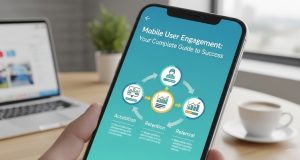Mobile App Marketing Strategies That Drive Downloads and Engagement

The mobile app market is one of the most competitive digital spaces. How can you make your app stand out in such a crowded field and get a hold? More than just turning an app out into the App Store or Google Play, successful mobile application marketing calls for a strategic, coherent, and dynamic approach to stealing and holding the users’ attention.
In this blog you will find practical and effective strategies for marketing mobile apps. From creating buzz before launch all through to promoting engagement after launch, we’re going to tell you everything you need to know about maximizing the chance that your app will succeed.
Why Mobile App Marketing Matters
Even the most innovative app can fail without the right promotional strategy. According to Statista, there were over 3.55 million apps on Google Play and 1.6 million on the Apple App Store as of 2023. With numbers like these, users won’t just stumble upon your app. It’s your job to get it in front of the right audience.
Mobile app marketing helps in multiple ways:
- Improves visibility: Cutting through the digital noise requires consistent and well-targeted strategies.
- Drives downloads: The more visible your app, the higher the likelihood of download spikes.
- Builds loyalty: A solid plan keeps users engaged long after they’ve downloaded your app.
If you’re ready to adopt strategies to help your app succeed, read on.
Pre-Launch Strategies for Mobile App Marketing
Effective app marketing begins long before launch. By creating momentum in advance, you maximize the chances of a successful debut.
1. Conduct Thorough Market Research
Before anything else, deeply understand your target audience and competitors.
- Target audience: Identify who you’re building the app for. What are their pain points, demographics, and habits?
- Competitive analysis: Review apps with similar features or within the same niche. Look at their user reviews to uncover strengths and weaknesses, and use these insights to improve your app.
Example:Creating a workout tracker app? Study competitors like MyFitnessPal. Check user reviews for what users love and what frustrates them. Use this information to refine unique features.
2. Build a Landing Page
A simple but well-designed landing page acts as a hub for key information about your app. Include elements like:
- A clear value proposition
- Screenshots and videos showcasing the app in action
- A pre-registration option to collect user emails for updates
[Pro Tip]: Include a countdown timer to build hype as the launch date approaches.
3. Set Up Social Media Profiles
Start creating buzz on social platforms like Instagram, Facebook, Twitter, and TikTok. Post sneak peeks of the app, share behind-the-scenes development updates, or engage with quizzes and polls. This builds curiosity and anticipation for your app.
4. Reach Out to Influencers
Partnering with niche influencers can fast-track your reach. If your app targets fitness enthusiasts or gamers, identify micro or macro influencers in those spaces to help promote your pre-launch campaign.
Post-Launch Mobile App Marketing Strategies
1. Optimize App Store Presence (ASO)
App Store Optimization (ASO) is critical for making your app discoverable. A well-optimized app store listing includes:
- Effective title and keywords: Use high-search, relevant terms in the name and description (e.g., “Budget Tracker App for Free” instead of just “Budget App”).
- Eye-catching visuals: Use high-quality screenshots and engaging preview videos.
- Clear description: Write a concise but informative description of what your app does and why it’s useful.
[Statistic]: Apps with a clear video preview experience up to 25% more downloads.
2. Leverage Paid Campaigns
Running Google Ads and Apple Search Ads (paid ads tailored for app promotion) can drive immediate visibility. For effective campaigns:
- Use targeted keywords related to your app’s niche.
- Use A/B testing for visuals and copy to see what resonates best.
- Focus on offers, like free trials, to incentivize downloads.
3. Implement Push Notifications
Did you know that push notifications significantly drive retention? Whether reminding users about app features or delivering limited-time offers, notifications re-engage users who may have lapsed. However, don’t overdo it. Excess notifications could lead to uninstalls.
- Examples of push notifications:
-
- “Track your meals today and stay on top of your fitness goals!”
- “You left 3 items in your cart. Complete your order now and enjoy free shipping!”
4. Use Social Media and UGC (User-Generated Content)
Post-launch, social media becomes a vital channel to keep the buzz going.
- User-Generated Content: Encourage app users to share their experiences on social platforms. You can even run campaigns or contests based on this content.
- Interactive content: Retail apps, for instance, can share styling hacks or shopping tips through short videos or live streams. The key lies in staying visual and engaging.
5. Invest in Referral Marketing
Turn your users into your brand advocates. Offer rewards for sharing your app with their network, such as free features, extra credits, or gift cards.
Real-life example:** Dropbox runs an effective referral program, giving both the referrer and their friend additional cloud storage when they sign up.**
6. Regularly Update Your App
Continuous improvement is essential for user satisfaction and long-term retention. Pay close attention to analytics, reviews, and user feedback to tweak features or fix bugs. Positive app updates signal reliability and value to app store algorithms, improving search ranking.
Metrics to Monitor Success
You can’t improve what you don’t measure. Regularly monitor these KPIs:
- App Downloads
- Retention Rates (percentage of users who return after download)
- Daily/Monthly Active Users (DAU/MAU)
- Cost-Per-Click (CPC) for paid campaigns
- User Feedback/Reviews
Understanding these metrics provides the actionable insight needed to scale your app to its full potential.
Make Your App Stand Out in 2024
If you want to make your app stand out in 2024, it’s important that you look at two things: Provide users with an experience that is both better than their expectations, and be first to sniff out whatever new trends come up. Start by making sure that the user interface of your app (UI) is intuitive, visually appealing and universally accessible even to users in different regions. Speed and performance come first, users love apps that load quickly and are satisfying to use. Leverage cutting-edge technology such as AI and ML to personalize experiences and provide predictive recommendations.
So your app needs to be both a unique experience and one which is in vogue. Future success in 2024 will depend on this. First off, establish your app’s user interface is intuitive, visually appealing and accessible to everyone. Clean design contributes not only to a higher uptake of your features but also greatly increases the number clicks that link out their site for information on other aspects of what you’re doing Within responsive design you can use a number of images to make your illustration dynamic Finally, be flexible and pay close attention to trends on the market.








